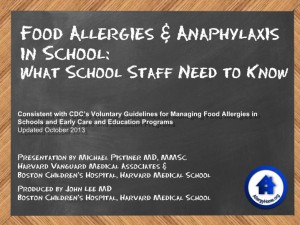 PREVIOUS MYTH:
Hand sanitizing gels eliminate food allergens
PREVIOUS MYTH:
Hand sanitizing gels eliminate food allergens
 NEXT MYTH:
All anaphylactic reactions have skin symptoms
NEXT MYTH:
All anaphylactic reactions have skin symptoms PREVIOUS MYTH:
Hand sanitizing gels eliminate food allergens
PREVIOUS MYTH:
Hand sanitizing gels eliminate food allergens
 NEXT MYTH:
All anaphylactic reactions have skin symptoms
NEXT MYTH:
All anaphylactic reactions have skin symptoms
 Staff Training: Food Allergies & Anaphylaxis in School – What School Staff Need to Know
Staff Training: Food Allergies & Anaphylaxis in School – What School Staff Need to Know
This 30 minute module is designed to assist the school nurse in staff training of management of life-threatening allergic reactions and increase food allergy awareness for all school staff including teachers, food service personnel, administrators, aides, specialists, coaches, bus drivers, custodians and others.
“Advisory statements don’t mean anything. They’re only there to protect a company from liability.”
Avoid products with advisory labeling for the allergen of concern.
These statements are written in numerous formats and under no regulation. Examples include “may contain traces of,” ” produced in a facility that,” also, “manufactured on shared equipment with,” etc. In “Consumer attitudes and risks associated with packaged foods having advisory labeling regarding the presence of peanuts”, Hefle and colleagues demonstrated that 7% of products with advisory labeling for peanut had detectable amounts of peanut in them. They also found that the terms used did not correlate with allergen levels. Similar studies had very similar findings. Some recommendations regarding cautionary statements vary depending on the allergen in question and the individual child . Assume that the students that you care for must avoid advisory statements unless otherwise notified from the school nurse or healthcare provider.
Avoid Allergen; Label Reading Essentials: Two page supplemental handout to reinforce school staff label reading skills.
Living Confidently With Food Allergy:Understanding Labels: Chapter from parent handbook that reviews label reading basics and tips to teach children.
All information contained on the Schools.AllergyHome.org website is intended for informational and educational purposes. The information provided on this website is not intended to be a replacement or substitute for professional medical advice. Any information that you have received from Schools.AllergyHome.org should be verified with your licensed health care provider. Furthermore, decisions regarding medical care should not be based solely upon the content of this website but made after discussions with your health care provider. Consumers should never disregard or delay seeking medical advice due to the content of this site.
Your use of this site does not create a patient-physician relationship between you and AllergyHome.org.
Medical information changes constantly. Therefore the information on this site or on the linked websites should not be considered current, complete or exhaustive, nor should you rely on such information to recommend a course of treatment for you or any other individual. Reliance on any information provided on this site or any linked websites is solely at your own risk.
Please note that AllergyHome is not affiliated with Boston Children’s Hospital